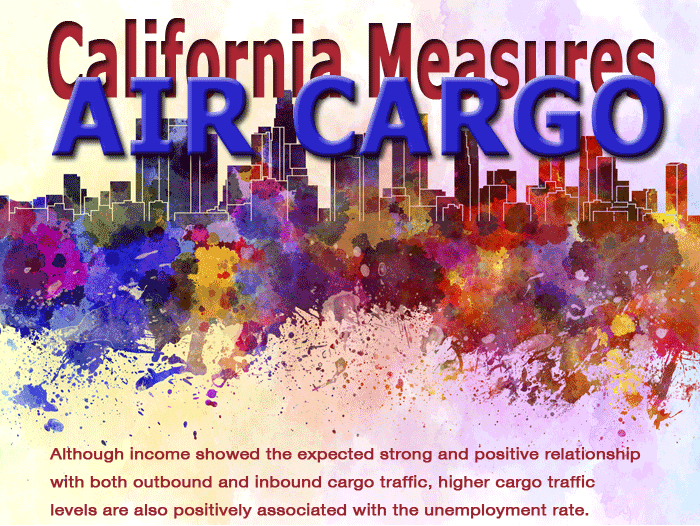California Measures Air Cargo

The institutional air cargo
industry gathered in Los Angeles earlier this year for its annual IATA
World Cargo Symposium with Hollywood serving as the backdrop—quite
a propos given the various stunts, sets, and stars.
To put things in context, California represents
the 8th largest economy in the world (if it were a country) with 38
million people, or 13 percent of the U.S. population. The 2012 gross
state product was 2 trillion dollars, or 12.9 percent of the U.S. GDP.
Closer to air cargo, LAX ranks 14 on the
ACI (Airports Council International) list of the world’s largest
cargo airports, while Long Beach is the number one container port in
the U.S.
Given these statistics, what happens in
California may well have general applicability industry wide. San Francisco-–Oakland,
San Diego, San Jose, and Ontario round off LAX to rank in the top 16
airports in the U.S. for cargo [and top five in California].
The data was gleaned from DOT records
(Form 41 Traffic and T-100 segment tables), starting with Q1 of 2003,
and aggregates freight and mail at airports with more than 100,000 pounds
and up annually.
It’s rather coincidental that in
January 2014, the Institute of Transportation Studies at the University
of California, Irvine, published a study titled “Determinants
of Air Cargo Traffic in California.”
No Crystal Ball Results
UCI is the 5th top transportation engineering
research institute in the world.
Rather than yet again hearing air cargo
insiders make pronouncements from their respective crystal balls, let’s
take a peek at what the academics are saying.
While, admittedly, a study comprising
the entire U.S. would have value, the authors concluded that because
of its size and special blend of its economy, the “state-level
analysis is also appropriate.”

 The
“study aims to estimate the socioeconomic determinants of air
cargo tonnage at airports in California [based on] a 7-year panel (2003-2009)
using quarterly employment, population, and traffic data of metro areas
in the state.”
The
“study aims to estimate the socioeconomic determinants of air
cargo tonnage at airports in California [based on] a 7-year panel (2003-2009)
using quarterly employment, population, and traffic data of metro areas
in the state.”
Furthermore, it also examines “how
the total air cargo traffic at airports in California is affected by
the characteristics of the corresponding metropolitan economies.”
The authors, Ph.D. candidate Paulos Ashebir
Lakew (left) and Andre Tok, Ph.D., (right) go on to say:
“Our results confirm our expectation
that the shares of manufacturing and government-related employment have
a considerable impact on outbound air cargo traffic. Outbound cargo
traffic is also found to be proportionate with city size while the corresponding
inbound traffic increases less than proportionally to population. Income
and service-related jobs are found to play a substantial role in determining
both outbound and inbound air cargo movement.”
The Findings
One insight isn’t a surprise—achieving
balance in the bi-directionality of air cargo, which has been a long-standing
challenge from the early days of the industry—is a critical factor
in a successful operation.
What the study aims to reveal is what
drives inbound and outbound air cargo to a particular airport. Another
finding, which may be surprising, given that most of the industry and
media focus has been on what has been happening since 2008, is that
while “…the expansion of air cargo transportation initiated
numerous studies on the role of goods movement by air, current numbers
show that the growth of air cargo traffic in California has slowed down
markedly over the 2000-2009 period.” Lakew and Tok have sampled
data for 22 airports across 15 metropolitan areas in California.
Earlier research is cited, which points
to spars literature dealing with how air freight impacts the California
economy. A 1988 study mentioned that at the time, over 50 percent of
its exports [in terms of value] were moved by air. To put it in perspective,
total California exports equated 1.24 trillion dollars between 1998
and 2008, encompassing express, small packages, pharma, perishables,
and special purpose equipment! This has been particularly important
for exports to the Pacific Asia region. For
the 2003-2009 timeline, passenger and combi aircraft carried 11.8 percent
of the cargo originating in California.
Air Cargo & Jobs
The pair documents that there is a “direct
relationship between metropolitan socioeconomic factors and air cargo
traffic, with manufacturing and services industries employment having
a strong impact… despite the sharp fall of statewide computer
and technology manufacturing employment after the 2000 dot.com bubble.”
The authors suggest that their conclusions
could be used to determine how airport development policies affect decisions
carriers make regarding hub and routing options. Naturally, the ranking
of California airports matches the population of the respective metropolitan
areas; however import air cargo increases are less dependent on city
size, yet more pronounced as it relates to exports.
Interestingly, “white collar job concentration increases inbound
traffic and both white collar and blue collar employment raise outbound
air cargo traffic in California.” It also seems to suggest that
large metropolitan areas are self-reliant.
The equation used for the base model of
the study looked at a number of factors, including age and average weekly
wages, together with the percentage of unemployed population of the
total labor force.
Thus, for instance, a relationship exists
between the numbers of workplaces near an airport—“increased
cargo traffic can introduce more jobs within the vicinity of an airport
and change the city’s employment shares.”
Demographics aside, a seemingly seldom-considered
influence is attributed to “…an unobserved variable or the
high demand for children’s toys and gaming consoles.”
“A 1 percent increase in average
weekly wages raises total outbound cargo at a major metropolitan area
by 2.7 percent while also raising inbound cargo tons by 3.5 percent.”
San Francisco Bay area is a case in point,
with average wages well above the California average and corresponding
high volumes of cargo, based on Q4 2009 figures. It follows that high-tech
companies rely heavily on importing components for their finished products.
In contrast, manufacturers depend far
less on air cargo for raw materials for their products, which are less
time sensitive.
Additionally, after 2000, “manufacturing
employment in California fell by 27 percent over three years.”
The Integrators
According to the study, the integrators/express
carriers play a prominent role in serving the supply chain requirements
for the California service industries because of the frequent next-day
aspect of their businesses.
Other Voices
The last metric examined deals with the fact
that “small airports in the 100 mile vicinity of a city with a
large airport will experience traffic diversion.”
This is stronger for imports, which the
authors conclude indicates “shippers and forwarders greatly prefer
flying air cargo goods to an airport, even if the final destination
of the goods being shipped is closer to a small airport.”
The respective ratio is listed at 78 percent
of outbound and 92 percent of inbound air cargo being diverted from
small to large airports within the given range.
Summary & Conclusions
•
While most variables exhibited the expected
results, we were surprised to find that the cargo effect of the construction-employment
share, an indicator of economic strength, is consistently negative.
•
Along with the comparable results for the
share of construction employment, the data suggests that a higher concentration
of blue collar jobs lowers inbound air cargo traffic levels.
•
Although income showed the expected strong
and positive relationship with both outbound and inbound cargo traffic,
we were surprised to find that higher cargo traffic levels are also
positively associated with the unemployment rate.
•
Considering the recent airport capacity concerns
expressed by the aviation community in California, we hope to have identified
some key determinants of air cargo traffic.
Ted Braun





